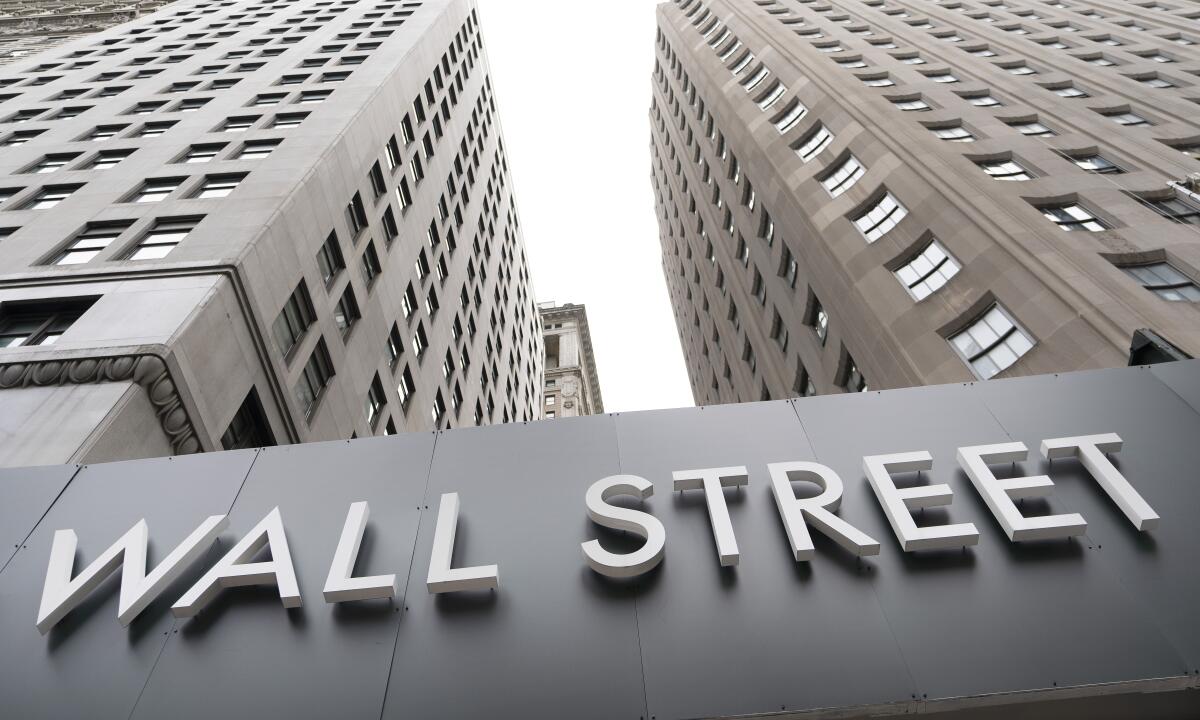Stock indexes close lower as jobs data spark uncertainty

- Share via
Wall Street capped a wobbly day of trading with a broad slide for stocks Friday, after a weak jobs report raised questions about the Federal Reserve’s timeline to pare back its immense support for markets.
The Standard & Poor’s 500 index fell 0.2% after wavering between small gains and losses for much of the day. The modest drop snapped a three-day winning streak for the benchmark index. Even so, it managed a 0.8% gain for the week, making up less than half of the index’s loss last week.
The Dow Jones industrial average fell 8.69 points, or less than 0.1%, to 34,746.25, while the Nasdaq composite slid 74.48 points, or 0.5%, to 14,579.54.
While regulators investigate a spate of Teslas steering themselves into parked vehicles, Tesla owners have been reporting faulty collision-avoidance systems.
Wall Street reacted with uncertainty and disappointment to the highly anticipated September jobs report. U.S. stocks moved up and down throughout the day, as did Treasury yields.
The yield on the 10-year Treasury climbed to 1.60% from 1.57% late Thursday after initially dropping to 1.56% immediately following the jobs report’s release.
Small-company stocks fell more than the broader market. The Russell 2000 index dropped 17 points, or 0.8%, to 2,233.09.
Much of Wall Street assumed the job market had improved enough for the Fed to soon begin paring back its monthly purchases of bonds meant to hold down longer-term interest rates. Investors had also pegged the central bank to begin lifting short-term interest rates late next year. Current super-low interest rates have been one of the main forces driving stocks to record heights.
But Friday’s jobs report showed that employers added just 194,000 jobs last month, well short of the 479,000 that economists expected. Many investors still expect the Fed to stick to its timetable, but the numbers were weak enough to at least raise questions about whether it may wait longer to taper its bond purchases or to eventually raise short-term rates.
“The miss on jobs isn’t pretty — there’s no way around it,” Mike Loewengart, managing director of investment strategy at E-Trade Financial, said in a statement. “And many may believe it will cause the Fed to pause in terms of their tapering strategy. But the jury is out on how the market will interpret the data.”
Underneath the surface, the numbers don’t offer much more clarity. The unemployment rate ticked down to 4.8% from 5.1%, and the government revised past months’ hiring numbers higher. But last month’s hiring was still the weakest since December. Average wages also rose a bit faster from August than expected, which helps workers but adds to worries about inflation.
“It gives the Fed a little bit more wiggle room on tapering and tightening in general,” said Cliff Hodge, chief investment officer for Cornerstone Wealth.
Inflation remains a big concern for investors after climbing to its highest level in at least a decade, in part because of snarled supply chains as the global economy reboots from its pandemic-caused shutdown. Those supply chain issues will be a key point for investors as they review companies’ next round of quarterly financial reports.
“Earnings season is really going to be the next catalyst for the market to understand where to go through the end of the year,” Hodge said.
Do you live among million-dollar homes? These 15 L.A. neighborhoods crossed the $1-million threshold
Rising energy prices have also contributed to inflation, and benchmark U.S. crude for delivery in November briefly topped $80 a barrel early Friday. That’s the highest the front-month contract for U.S. oil has been since 2014.
That helped drive energy stocks in the S&P 500 up 3.1%, by far the biggest gain among the 11 sectors that make up the index. Exxon Mobil rose 2.8%, and Pioneer Natural Resources climbed 4.6%.
Roughly 3 in 5 companies in the S&P 500 closed lower, with losses in technology and healthcare companies accounting for a big share of the slide. Citrix Systems fell 5.7%, while Bristol-Myers Squibb closed 3% lower. Only energy stocks and banks notched gains.
Friday’s choppy trading extends an already volatile run since the S&P 500 set its record high Sept. 2. A swift rise in interest rates and the prospect of less support from the Fed have forced investors to reassess whether stock prices have grown too expensive. The worries about higher interest rates have also combined with political turmoil in Washington.
The S&P 500 had four straight days through Tuesday on which it alternated between a gain of 1% and a loss of 1%. In recent days, the market has been more stable amid optimism over progress in Congress on averting a disastrous default on the U.S. federal debt.
Stock markets overseas closed uneven Friday. In Europe, Germany’s DAX lost 0.3%, and France’s CAC 40 fell 0.6%. London’s FTSE 100 rose 0.2%.
Asian markets were stronger. Japan’s Nikkei 225 rose 1.3%, South Korea’s Kospi added 0.6%, and stocks in Shanghai gained 0.7%.
Associated Press writer Joe McDonald contributed to this report.
More to Read
Inside the business of entertainment
The Wide Shot brings you news, analysis and insights on everything from streaming wars to production — and what it all means for the future.
You may occasionally receive promotional content from the Los Angeles Times.











